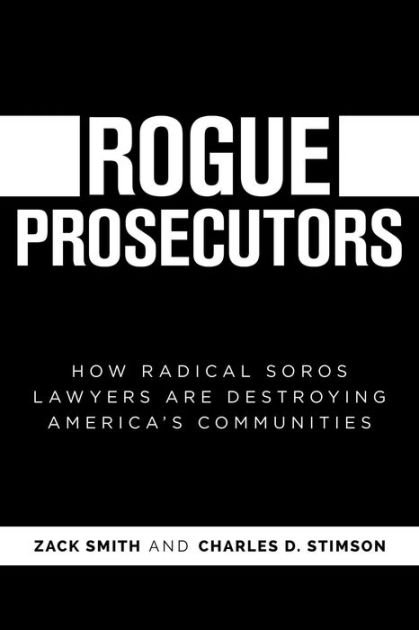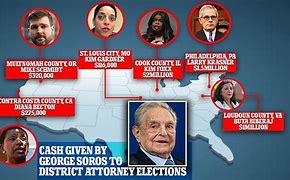Rogue Prosecutors: The Legal Road to Dystopia
The subtitle says it all: “How Radical Soros Lawyers are Destroying America’s Communities.”
This essay originally appeared in Law & Liberty on September 11, 2023 (here). Thanks to Power Line, Instapundit (here), and Real Clear Policy (here)!
Kim Foxx in Chicago. Alvin Bragg in New York. George Gascon in Los Angeles. Larry Krasner in Philadelphia. Chesa Boudin in San Francisco. Marilyn Mosby in Baltimore. Rachael Rollins in Boston. Kimberly Gardner in St. Louis. Most Americans are familiar with at least some of these names from news reports of urban carnage, wanton lawlessness, and lax enforcement (or non-enforcement) of laws designed to protect persons and property from predation. Their names, and unfortunately many others– collectively comprising the prosecutors in nearly half of America’s most populous cities–form the ranks of pro-criminal, anti-victim zealots whose election campaigns were funded by billionaire activist George Soros and other leftist oligarchs. At least 72 million Americans are estimated to be subject to the misrule of these rogue prosecutors.

Instead of fighting crime and representing the interests of the law-abiding public, these so-called prosecutors do the opposite: overseeing sharp increases in crime and advocating on behalf of criminals. Public safety—per Federalist 3, the paramount goal of civil society–depends on the arrest, conviction, and punishment of criminals. The rule of law requires the even-handed application of duly-enacted laws. Removing these civilizational underpinnings creates social turmoil that far-left activists hope to exploit. Soros’s bold gambit is transforming America’s cities by shattering norms, producing chaos and disorder, and, as urban areas become uninhabitable, hastening the exodus of businesses and residents.
The resulting “broken windows” phenomenon is not an accident; nor is it spontaneous. Radicals wishing to undermine the stability of society–to establish what some pundits have termed a state of “anarcho-tyranny”—assiduously follow Saul Alinsky’s playbook. One of “community organizer” Alinsky’s tenets in Rules for Radicals was “Whenever possible go outside the experience of the enemy. Here you want to cause confusion, fear, and retreat.” Using Union General William T. Sherman’s Civil War tactics in his infamous March to the Sea as a “classic example,” Alinsky observed that “The South, when confronted with this new form of military invasion, reacted with confusion, panic, terror, and collapse.”
Progressive prosecutors wreaking havoc in many American cities are seemingly intent on replicating this result: the collapse of urban communities. The common agenda of Soros-funded prosecutors is to undermine public safety and thwart the rule of law through non-enforcement of criminal laws, unwarranted leniency toward dangerous offenders, release of violent felons from incarceration, and the refusal to detain dangerous or repeat criminals prior to trial by eliminating the cash bail system. Pursuant to progressives’ playbook, the resulting “emergency” would justify an extraordinary “solution.” Using a variation of the Cloward-Piven strategy, the ultimate goal of these rogue prosecutors is to consolidate power in the hands of trusted apparatchiks. In this case, however, the “emergency” is wholly manufactured, and therefore avoidable.
Rogue Prosecutors, written by two former prosecutors now affiliated with the conservative Heritage Foundation, Zack Smith and Charles Stimson, is the most detailed summary I have seen of the rise of “Soros-funded prosecutors”—covering in comprehensive detail their origins, beliefs, and strategies, as well as the money and individuals behind the movement. The rogue prosecutor movement, since it began in 2015, has caused incalculable damage to public safety across the nation. With over 300 pages of text and more than 1,100 footnotes, Rogue Prosecutors is impressively thorough, with detailed analyses of crime rates (before and after), recidivism, the intellectual lineage of the radical anti-prison/anti-police (or “abolitionist”) movement, and the failed experiment of “bail reform.”
The authors unmask Team Soros, naming names, following the money, and lifting the curtain on the shadowy network of affiliated PACs, foundations, and shell organizations used to bankroll rogue prosecutors. Drawing on the work of noted criminologist Barry Latzer and others, the authors also debunk the many fallacies and misconceptions regarding crime rates, incarceration rates, the composition of prison populations, and the often-overlooked demographics of crime victims. The book closes with some sensible suggestions for alternatives to incarceration (diversion programs such as domestic violence courts, drug courts, and the like), and a brief vignette about the experience of a major city (San Diego) prosecutor who beat a Soros-funded challenger. It can be done.
As Smith and Stimson explain, the abolitionist movement is based on two myths aggressively promoted in woke academia and progressive media outlets: First, that America faces a “mass incarceration” crisis that can only be solved by reducing arrests, shortening sentences, and de-populating prisons. Second, that our criminal justice system is systemically racist due to the disproportionate number of African-Americans who are arrested, convicted, and incarcerated. Leftist critics risibly refer to America’s criminal justice system as “the new Jim Crow.” Because the criminal justice system is a tool of oppression, the argument goes, it must be drastically reformed in the name of “racial equity. Never mind that African-Americans commit a disproportionate percentage of crimes—including violent crimes—usually against victims who are disproportionately African-American. By promoting lawlessness, rogue prosecutors harm the very communities they claim to help.
Citing the work of their Heritage colleague, Mike Gonzalez, the authors explain that the roots of the abolitionist movement date back to Marxist-inspired New Left intellectuals in the 1960s and 1970s, including two-time Communist Party USA nominee for Vice President, Angela Davis, who wrote an influential 2003 book entitled Are Prisons Obsolete? In an enlightening survey of the scholarly literature, the authors illustrate that the radical origins of the abolitionist movement overlap with those of Black Lives Matter. Proponents of both seek to overthrow what they refer to as the “carceral state,” a term that equates imprisonment for committing a crime with political (or racial) oppression.
The heart of the book, however, consists of chapter-length profiles of each of the eight rogue prosecutors listed in the opening paragraph. (Boudin was recalled in 2022, Mosby was defeated in 2022 (while under indictment), and Rollins, promoted to U.S. Attorney by President Biden in 2022, resigned to end an ethics probe in 2023.) The profiles do not present a flattering portrait of the state of democracy in America, to say the least. Uniformly contemptuous of public safety, enthralled by identity politics, rigidly hewing to far-left positions, and, most importantly, grossly incompetent at their jobs, these rogue prosecutors elicit sympathy for the unfortunate public they represent. Perhaps their constituents will learn that elections matter.
The astounding (and confounding) aspect of the abolitionist movement is the rapidity with which it evolved from a fringe academic theory into disastrous public policy affecting many of our major cities. Thank Team Soros, and their network of academic and media wingmen, for that. The authors bemoan the “cottage industry of law review articles” that has emerged in recent years demonizing our criminal justice system as a “racial caste system,” and worse. Many urban voters have, sadly, adopted the false, anti-police narrative peddled by the rabid critics of law enforcement.
The strategy of supporting the candidacy of committed “progressives” for low-visibility, down-ballot positions such as district attorney or state’s attorney was undeniably ingenious. Instead of mustering vast legal resources to fight the death penalty, case-by-case (as the ACLU and other groups have done for decades); engaging in expensive statewide political campaigns to elect progressive candidates to the legislature, hoping to achieve a sympathetic majority; or lobbying Congress, state legislatures, or city councils to pass laws aligning with the progressive agenda, in 2015 Team Soros devised an alternative strategy: cherry-picking political campaigns for the office of district attorney in target cities.
Deep-pocketed donors (and George Soros certainly qualifies in this regard) discovered they were able to finance the election of like-minded attorneys who shared the donors’ ideological agenda, using “dark money” front groups with innocuous names, such as the “Safety and Justice” PAC and the “Fair and Just Prosecution” project. Running successful campaigns in low-turnout races generating little public visibility requires modest resources compared to playing in national or even statewide politics. The $40 million Soros has spent so far backing rogue prosecutors is a fraction of what he and other special interests contribute to candidates in other races, but it represents a vast sum for typically low-budget prosecutor campaigns. Accordingly, Team Soros is able to easily outspend incumbent prosecutors with limited resources. Moreover, urban electorates are more susceptible to campaign themes featuring identity politics and anti-police rhetoric. So far, it is a winning strategy.
In large cities, a single elected official–the district attorney—wields as much power as the entire legislative and judicial branches. Prosecutorial discretion can override the work of the legislature. Who needs to abolish the death penalty if prosecutors no longer seek it? Who needs to de-criminalize drugs, “public order” crimes, and similar offenses (including shoplifting and petit larceny) if prosecutors can decide simply not to charge those arrested for such crimes—so-called “prosecutorial nullification”? Homeless encampments can be created, virtually overnight, by non-enforcement of vagrancy laws and bans on “camping” in public spaces. Judges can only punish criminals who are arrested and charged.
Buying district attorney seats in this fashion allows Team Soros to circumvent the legislature and the police and the courts when, once elected, rogue prosecutors selectively and arbitrarily choose which laws to enforce—or not. The election of a rogue prosecutor can completely alter the operation of the criminal justice system in that jurisdiction. By the time the voters realize the consequences of their decision, it is too late. Unless the rogue prosecutor is recalled, as was the case with Chesa Boudin in San Francisco, the public is stuck with the consequences until the next election. In the meantime, the Soros-funded rogue prosecutor may have gutted his staff by firing experienced career prosecutors—causing irreparable damage.
Despite its grim message, Rogue Prosecutors represents a welcome return to a conservative mainstay—law and order—following a short-lived flirtation by some center-right groups and figures with “criminal justice reform,” derided by critics as “soft on crime.” Sporting blurbs by former Attorney General Ed Meese, Andrew McCarthy, Heather Mac Donald, and the Manhattan Institute’s Rafael Mangual, the book is a devastating critique of Soros’ cynical plan to undermine public safety by financing the election of William Kunstler-style defense attorneys masquerading as prosecutors. It deserves to be widely read.
My only quibble with Rogue Prosecutors is that the book lacks an index and bibliography, and the consecutively-numbered footnotes don’t always match the text. Perhaps these minor shortcomings could be corrected in future printings, thereby enhancing the book’s usefulness as an encyclopedic reference work.

































